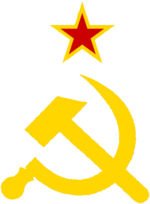Communist Party of the Soviet Union (TheodoresTomfooleries): Difference between revisions
(MISTAKE AAAAH!!!) |
No edit summary |
||
| Line 18: | Line 18: | ||
| membership_year = 2019 | | membership_year = 2019 | ||
| membership = {{increase}} 21,320,201 | | membership = {{increase}} 21,320,201 | ||
| ideology = '''{{wp| | | ideology = '''{{wp|Communism}}'''<br> | ||
*{{wp| | *{{wp|Marxism-Leninism}} | ||
*{{wp|Socialist patriotism}} | *{{wp|Socialist patriotism}} | ||
*{{wp|Soviet patriotism}} | **{{wp|Soviet patriotism}} | ||
*{{wp|Social conservatism}} | |||
| position = {{wp|Far-left politics|Far-left}} | | position = {{wp|Far-left politics|Far-left}} | ||
| affiliation1_title = National affiliations | | affiliation1_title = National affiliations | ||
Revision as of 23:11, 4 March 2024
Communist Party of the Soviet Union Коммунистическая партия Советского Союза | |
|---|---|
 The Hammer and sickle and Red star is often used as a symbol of the CPSU. | |
| Abbreviation | CPSU |
| General Secretary | Sabrican Garayev |
| Founded | January 1912 |
| Split from | Russian Social Democratic Labour Party |
| Preceded by | RSDLP |
| Headquarters | 4 Starya Square, Moscow |
| Newspaper | Pravda |
| Youth wing | Little Octobrists (Ages 7-9) Young Pioneers (Ages 9-14) Komsomol (Ages 14 - 28) |
| Membership (2019) | |
| Ideology | Communism |
| Political position | Far-left |
| Slogan | Workers of the world, unite! |
| Anthem | The Internationale |
| Party flag | |
 | |
| Website | |
| en.cpsu.su | |
The Communist Party of the Soviet Union (CPSU), colloquially "the party", is the founding and ruling party of the Union of Soviet Socialist Republics. It is among the largest political parties in the world, with a reported membership of 21.32 million in 2019, and it is the second largest Marxist-Leninist political party worldwide. The CPSU is constitutionally the "leading and guiding force of the Soviet society" and holds a political monopoly regarding politics.
The CPSU can trace its roots directly to the Russian Social Democratic Labour Party, a Marxist group founded in late 19th century Imperial Russia. Vladimir Lenin joined the party before its 2nd congress in July-August 1903. The congress resulted in the party splitting into two factions, brought on by a dispute over whether the party should be of professional revolutionaries or if membership should be loose. Lenin lead the Bolsheviks, a faction of radical revolutionary socialists which called for society to be organized based on democratic centralism and for the revolution to be organized by a vanguard party while the Mensheviks, while still revolutionary, were much more liberal and tame in their approach. By 1912, the Bolsheviks unofficially (and secretly) split off from the RSDLP, founding the RSDLP (Bolsheviks) at the Prague Conference. The Bolsheviks largely remained sidelined to the Mensheviks and the Social Revolutionaries (SRs) until the February Revolution. The Bolsheviks would go on to sieze control of Petrograd (now Leningrad) in a largely bloodless revolt in November 1917 (O.S. October}}, in what would be known as the Great October Socialist Revolution. The revolution was not universally recognised as legitimate and as a result the Russian Civil War broke out between the Bolsheviks and the White movement; by then the party had de-facto split off entirely from the RSDLP- this was made official on 8 March, 1918 with a name change at the 7th congress.
The Bolsheviks would go on to declare the Russian Soviet Republic, later renamed to the Russian Socialist Federative Soviet Republic, as well as set up and support numerous soviet republics across the former Russian Empire. In December 1922, the Treaty of Creation was signed, which united the signatories into a socialist federation known as the Soviet Union. Lenin died in 1924 due to complications brought on by a series of strokes the previous years. Joseph Stalin succeeded him and turned the General Secretary into the most powerful position in the Soviet Union. In 1925, the Russian Communist Party (B) was renamed to the All-Union Communist Party (B)- a name which it stuck with until 1952. Stalin centralized the party and gave it greater authority over the Soviet government and people. By 1929 the party had broken away from Leninism in favor of Marxism-Leninism, an ideology synthesized by Stalin throughout the 1920s. The party was also unofficially Stalinist until 1956, though Stalinism is not considered to be its own ideology. The party got its present name in 1952, less than a year before Stalin's death.
The CPSU follows the principles of Marxism-Leninism, Socialism in one country, and Democratic centralism. The Party Congress is the highest authority in the party, though when it is not in session the Central Committee takes charge; even then the Central Committee does not meet often, so day-to-day authority is trusted to the Party Politburo. The General Secretary is the highest authority in the party and subsequently is the unofficial leader of the Soviet Union.